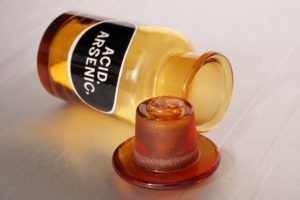History of Arsenic Use
Arsenic is a naturally occurring element found in bedrock formations throughout the United States, but most commonly in the West, Midwest and Northeast regions. Arsenic in groundwater supplies is a result of the dissolution of aquifer media, and is typically found in iron or sulfide bearing formations. The primary drinking water standard (MCL) for Arsenic is 10 parts per billion (ppb) or 10 micro grams per liter (µg/L), but the MCLG is 0. It is considered particularly dangerous, like lead or mercury, even at low concentrations, and has no visible color, taste, or odor when present. In 2000, the World Health Organization decreased the limit for arsenic in drinking water from 200 ppb to 10 ppb, forcing agencies like the EPA and other public health related organizations to adopt the same standard. Other sources of arsenic include industrial waste, mining operations, wood preservative, and herbicides/pesticides from agricultural applications. Up until the start of the 20th century, before the dangers of arsenic were public knowledge, arsenic was prescribed by doctors for treating a number of ailments. It was also used in paints and cosmetics, and in the textile industry as a brightening agent. Arsenic is still added to some animal feeds for poultry and swine production to promote growth, but has been phased out to some extent because of its toxicity.

Into the 19th century, Arsenic was commonly prescribed by doctors for different ailments and even used as a powder to brighten skin complexion.
Health Concerns
Due to its toxicity in very low concentrations, and the fact that it is nearly impossible to detect, all private well owners should have an EPA certified analytical laboratory test their well water. Arsenic is a known carcinogen that can cause skin, bladder, and lung cancer, and has been traced to cardiovascular and neurological diseases. According to the Centers for Disease Control, drinking water is the primary source for arsenic poisoning. In high enough concentrations, arsenic poisoning can result in vomiting and diarrhea, shock, and severe dehydration. According to the U.S. Geological Survey and Centers for Disease Control and Prevention, an estimated 2.1 million people in the United States may be getting their drinking water from private water wells considered to have high concentrations of arsenic, presumed to be from natural sources. Arsenic is most common in two forms; As(III), arsenite as H3AsO3 and H2AsO3 (1-) and As(V), arsenate as H2AsO4(1-) and HAsO4(2-). As(III) has no net charge and therefore needs to be converted to As(V) through oxidation by means of chlorination, ozonation, or oxidizing medias like KDF, which is a high-purity copper-zinc catalytic media. Many laboratories provide water analysis results as total arsenic and do not speciate between As(III) and As(V). It is important to know how much As(III) and As(V) are present, as this will dictate what course of treament is appropriate. As with other elements like lead or mercury that are toxic in very small levels, the goal should always be a complete reduction of arsenic or below detectable testing limits. For residential applications, the MCLG should always be complete arsenic removal, while a community well water system may only have to meet the MCL.
Treatment Options
The most common treatment options are oxidation followed by an arsenic adsorptive media, anion exchange, or reverse osmosis. As stated above, there are a number of oxidation treatment options available that work well. It is important to consider what other contaminants, like iron or manganese, may be present to ensure that complete oxidation of As(III) to As(V) can occur. After oxidation, the most common treatment approach is adsorption, or a combination of ion exchange and adsorption. The major benefits of many adsorption medias is the lack of need for regenerants such as sodium chloride, and the lack of arsenic dumping risk. The second most common POE treatment is to use a strong base anion exchange resin regenerated with sodium chloride. The strong base anion resin will exchange chloride for arsenic. Again, it is important to have a complete water analysis to determine what other anions, like sulfate or nitrate, may be present as they will compete with the arsenic during ion exchange. A proper anion analysis of the water is also important to make sure that the chloride levels in the treated water do not become excessive. Another common treatment option is point-of-entry (POE) or point-of-use (POU) reverse osmosis (RO) systems. You can learn more about our POE and POU RO systems by clicking this link.
Regardless of what treatment approach is being considered, a thorough analysis is always essential. All of the treatment technologies mentioned above have specific influent water quality requirements for proper operation. Strong base anion resin and POE R.O. may require post-treatment as well, depending on the influent water quality.









